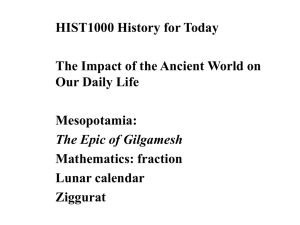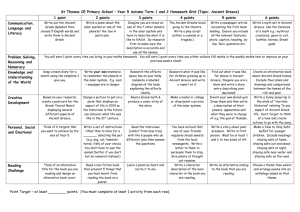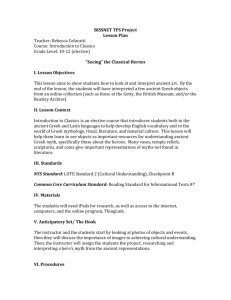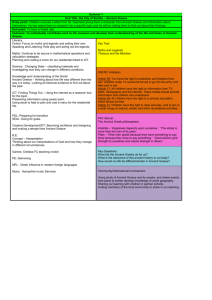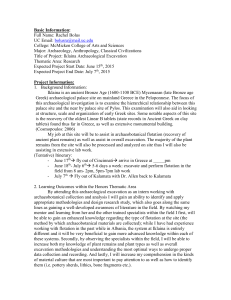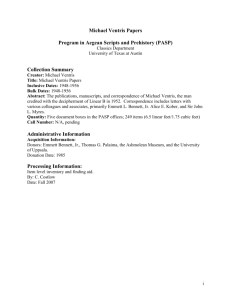all one can hope to find is more or less plausibility
advertisement
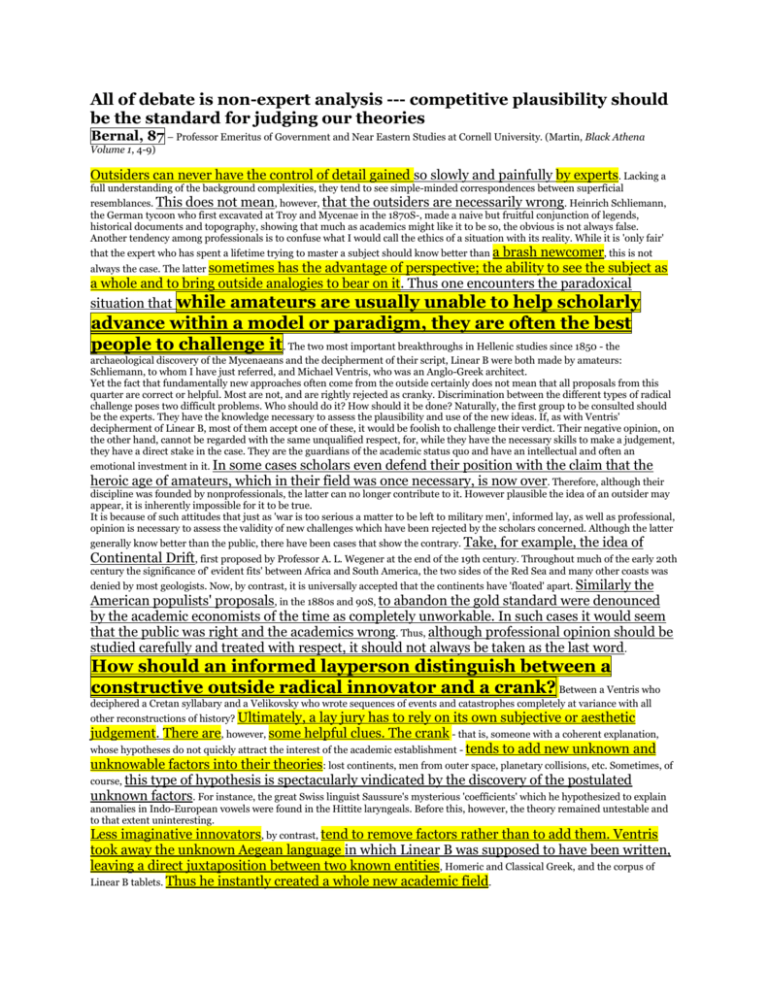
All of debate is non-expert analysis --- competitive plausibility should be the standard for judging our theories Bernal, 87 – Professor Emeritus of Government and Near Eastern Studies at Cornell University. (Martin, Black Athena Volume 1, 4-9) Outsiders can never have the control of detail gained so slowly and painfully by experts. Lacking a full understanding of the background complexities, they tend to see simple-minded correspondences between superficial resemblances. This does not mean, however, that the outsiders are necessarily wrong. Heinrich Schliemann, the German tycoon who first excavated at Troy and Mycenae in the 1870S-, made a naive but fruitful conjunction of legends, historical documents and topography, showing that much as academics might like it to be so, the obvious is not always false. Another tendency among professionals is to confuse what I would call the ethics of a situation with its reality. While it is 'only fair' that the expert who has spent a lifetime trying to master a subject should know better than a brash newcomer, this is not always the case. The latter sometimes has the advantage of perspective; the ability to see the subject as a whole and to bring outside analogies to bear on it. Thus one encounters the paradoxical situation that while amateurs are usually unable to help scholarly advance within a model or paradigm, they are often the best people to challenge it . The two most important breakthroughs in Hellenic studies since 1850 - the archaeological discovery of the Mycenaeans and the decipherment of their script, Linear B were both made by amateurs: Schliemann, to whom I have just referred, and Michael Ventris, who was an Anglo-Greek architect. Yet the fact that fundamentally new approaches often come from the outside certainly does not mean that all proposals from this quarter are correct or helpful. Most are not, and are rightly rejected as cranky. Discrimination between the different types of radical challenge poses two difficult problems. Who should do it? How should it be done? Naturally, the first group to be consulted should be the experts. They have the knowledge necessary to assess the plausibility and use of the new ideas. If, as with Ventris' decipherment of Linear B, most of them accept one of these, it would be foolish to challenge their verdict. Their negative opinion, on the other hand, cannot be regarded with the same unqualified respect, for, while they have the necessary skills to make a judgement, they have a direct stake in the case. They are the guardians of the academic status quo and have an intellectual and often an emotional investment in it. In some cases scholars even defend their position with the claim that the heroic age of amateurs, which in their field was once necessary, is now over. Therefore, although their discipline was founded by nonprofessionals, the latter can no longer contribute to it. However plausible the idea of an outsider may appear, it is inherently impossible for it to be true. It is because of such attitudes that just as 'war is too serious a matter to be left to military men', informed lay, as well as professional, opinion is necessary to assess the validity of new challenges which have been rejected by the scholars concerned. Although the latter generally know better than the public, there have been cases that show the contrary. Take, for example, the idea of Continental Drift, first proposed by Professor A. L. Wegener at the end of the 19th century. Throughout much of the early 20th century the significance of' evident fits' between Africa and South America, the two sides of the Red Sea and many other coasts was denied by most geologists. Now, by contrast, it is universally accepted that the continents have 'floated' apart. Similarly the American populists' proposals, in the 1880s and 90S, to abandon the gold standard were denounced by the academic economists of the time as completely unworkable. In such cases it would seem that the public was right and the academics wrong. Thus, although professional opinion should be studied carefully and treated with respect, it should not always be taken as the last word. How should an informed layperson distinguish between a constructive outside radical innovator and a crank? Between a Ventris who deciphered a Cretan syllabary and a Velikovsky who wrote sequences of events and catastrophes completely at variance with all other reconstructions of history? Ultimately, a lay jury has to rely on its own subjective or aesthetic judgement. There are, however, some helpful clues. The crank - that is, someone with a coherent explanation, whose hypotheses do not quickly attract the interest of the academic establishment - tends to add new unknown and unknowable factors into their theories: lost continents, men from outer space, planetary collisions, etc. Sometimes, of course, this type of hypothesis is spectacularly vindicated by the discovery of the postulated unknown factors. For instance, the great Swiss linguist Saussure's mysterious 'coefficients' which he hypothesized to explain anomalies in Indo-European vowels were found in the Hittite laryngeals. Before this, however, the theory remained untestable and to that extent uninteresting. Less imaginative innovators, by contrast, tend to remove factors rather than to add them. Ventris took away the unknown Aegean language in which Linear B was supposed to have been written, leaving a direct juxtaposition between two known entities, Homeric and Classical Greek, and the corpus of Linear B tablets. Thus he instantly created a whole new academic field. I maintain that the revival of the Ancient Model of Greek history proposed in these volumes belongs to this second category. It adds no extra unknown or unknowable factors. Instead it removes two introduced by proponents of the Aryan Model: (I) the non-IndoEuropeanspeaking 'Pre-Hellenic' peoples upon whom every inexplicable aspect of Greek culture has been thrust; and (2) the mysterious diseases of 'Egyptomania', 'barbarophilia' and interpretatio Graeca which, the 'Aryanists' allege, have deluded so many otherwise intelligent, balanced and informed Ancient Greeks with the belief that Egyptians and Phoenicians had played a central role in the formation of their culture. This 'delusion' was all the more remarkable because its victims gained no ethnic satisfaction from it. The removal of these two factors and the revival of the Ancient Model leaves the Greek, West Semitic and Egyptian cultures and languages in direct confrontation, generating hundreds if not thousands of testable hypotheses-predictions that if word or concept a occurred in culture x, one should expect to find its equivalent in culture y. These could enlighten aspects of all three civilizations, but especially those areas of Greek culture that cannot be explained by the Aryan Model. The Ancient, Aryan and Revised Ancient models share one paradigm, that of the possibility of diffusion of language or culture through conquest. Interestingly, this goes against the dominant trend in archaeology today, which is to stress indigenous development. The latter is reflected in Greek prehistory by the recently proposed Model of Autochthonous Origin.2 Black Athena, however, will focus on the competition between the Ancient and Aryan models. The 19th and 20th centuries have been dominated by the paradigms of progress and science. Within learning there has been the belief that most disciplines made a quantum leap into 'modernity' or 'true science' followed by steady, cumulative, scholarly progress. In the historiography of the Ancient East Mediterranean these 'leaps' are perceived to have taken place in the 19th century, and since then scholars have tended to believe that their work has been qualitatively better than any that has gone before. The palpable successes of natural science during this period have confirmed the truth of this belief in that area. Its extension to historiography is less securely based. Nevertheless, the destroyers of the Ancient Model and the builders of the Aryan believed themselves to be 'scientific'. To these German and British scholars, the stories of Egyptian colonization and civilizing of Greece violated 'racial science' as monstrously as the legends of sirens and centaurs broke the canons of natural science. Thus all were equally discredited and discarded. For the past hundred and fifty years, historians have claimed to possess a 'method' analogous to those used in natural science. In fact, ways in which the modern historians differ from the 'prescientific' ones are much less certain. The best of the earlier writers were selfconscious, used the test of plausibility and tried to be internally consistent. Furthermore, they cited and evaluated their sources. By comparison, the 'scientific' historians of the 19th and 20th centuries have been unable to give formal demonstrations of 'proof' or establish firm historical laws. Today, moreover, the charge of 'unsound methodology' is used to condemn not merely incompetent but also unwelcome work. The charge is unfair, because it falsely implies the existence of other methodologically sound studies with which to contrast it. Proof or certainty is difficult enough to achieve, even in the experimental sciences or documented history. In the fields with which this work is concerned it is out of the question: all one can hope to find is more or less plausibility. To put it in Considerations of this kind lead to the question of positivism and its requirement of 'proof' . another way, it is misleading to see an analogy between scholarly debate and criminal law. In criminal law, since conviction of an innocent person is so much worse than acquittal of a guilty one, the courts rightly demand proof 'beyond reasonable doubt' before a conviction can be made. But neither conventional wisdom nor the academic status quo has the moral rights of an accused person. Thus debates in these areas should not be judged on the basis of proof, but merely on competitive plausibility. In these volumes I cannot, and therefore do not attempt to, prove that the Aryan Model is 'wrong'. All I am trying to do is to show that it is less plausible than the Revised Ancient Model and that the latter provides a more fruitful framework for future research. 20th-century prehistory has been bedevilled by a particular form of this search for proof, which I shall call 'archaeological positivism'. It is the fallacy that dealing with 'objects' makes one 'objective'; the belief that interpretations of archaeological evidence are as solid as the archaeological finds themselves. This faith elevates hypotheses based on archaeology to a 'scientific' status and demotes information about the past from other sources - legends, place names, religious cults, language and the distribution of linguistic and script dialects. In these volumes it is maintained that all these sources must be treated with great caution, but that evidence from them is not categorically less valid than that from archaeology.
